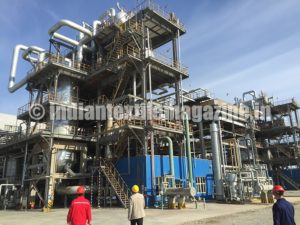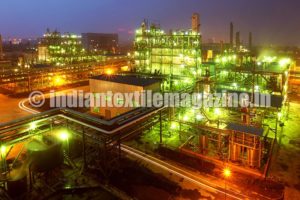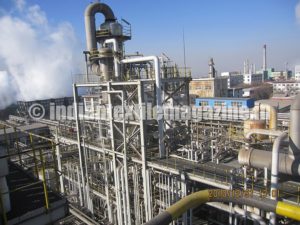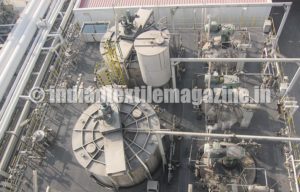POLYTEX is one of the most trusted international engineering companies. It has a dedicated team of highly experienced and skilled professionals and engineers to provide world-class turnkey project services like chemicals process, engineering design, procurement, implementation and commissioning in the field of fiber production. The company’s headquarters cover an area of 70,000 sq. mtrs. and includes an engineering R&D center, a machine processing center and a coal chemical technology center.
In 2015 and 2016, the Chinese company launched three engineering solutions for the global market.
Multi-product polyester line
As the global polyester market has become saturated, regular products and large capacity are no longer the bases for long-term development of polyester manufacturers. To cope with this problem, POLYTEX has launched a continuous polyester line for multiple products, which has been set up in India.
This production line has functions of producing film-grade, bottle-grade, and fiber-grade polyester at the same time. In addition, the engineering design of this line also covers some of the currently popular specialty polyester products.
For producing three items at the same time, three relatively independent polycondensation systems are adopted in the production line. To meet the different requirements, POLYTEX has set up three secondary esterification systems for the production line. Each secondary esterification system can be used independently. The utilization of the recycling system for ethylene glycol will completely separate the oligomer contained in various products from the polymerization system, thus reducing the raw material contamination caused by the manufacturing of multiple products.
To lower the equipment consumption and increase operational reliability, POLYTEX uses an independent PTA configuration system and first-esterification system for the production line. In addition, the new type esterification process tower uses an epochal design, which lowers the water content of ethylene glycol in the esterification process to a level of only 10% of the normal water content in conventional technologies. These improvements allow for simpler treatment methods for esterification waste water.
The polyester market changes frequently. POLYTEX system can easily cope with the market changes and produce high value-added products at maximum capacity. The line can make different products at the same time, without increasing engineering and labor force. In addition, the system can be designed to make low-melt-point, water-soluble, or film-grade products.
The production line has been built by the India-based CHIRIPAL. The whole project is provided by POLYTEX and production has already commenced in March last. The capacity of the production line is 600 tons per day (TPD) with fiber/film/bottle grade. With this production line, CHIRIPAL will further increase its competitiveness and change the image of the polyester market in India and its neighboring regions.
New gas/chemical plant
As the environmental pressure from carbon dioxide and nitrogen emissions grows, public concerns over environmental problems have increased significantly in recent years. Developing countries no longer focus on labor-intensive investment, and the governments and institutions in these countries have enacted corresponding policies to check the factors that cause environmental pollution.
To cope with the increasing production of chemical products under strict environment control, POLYTEX presents and implements new design ideas for the growing gas/coal chemical industry. For example, it has provided upgrading services for the whole process of a coal chemical plant of the Xinjiang Guanghui Energy Group. In the six months, from July 2015 to January 2016, POLYTEX reformed the whole coal chemical plant, including the heat quantity and cold quantity distribution system, which was an important bottleneck of former technologies; and the new system exchanges the heat quantity and the cold quantity of the waste or remnant heat energy in the equipment through two heat energy stations and distributes heat quantity and cold quantity to various parts of the coal chemical plant through pipelines.
In addition, POLYTEX significantly improves the cold chemical plant by changing pressure distribution in the devices, adding a refining and purification process, modifying the gasification process, and conversing the configuration of different energies.
The whole upgrading cost totalled $45 million. After eight months of operation, from January to August 2016, based on the previous operation data of the past few years, the plant owner concluded that under the same kind, same volume of raw materials and the same operation time, the capacity grew by 31%, the average water, power and gas consumption went down by 15%, the emission of flare tower was down 75%, and the data of nitrogen emission and carbon emission are still being calculated. These data results reveal that the upgrading of the plant was very profitable. The net income of the plant increased significantly, if one only considers the higher production of 500 metric tons of LNG and 800 metric tons of methanol per day.
The success of the previous POLYTEX projects provided a reference for similar customers. POLYTEX can arrange technical personnel to carry out diagnosis and data tests for the manufacturing process suited to different situations of different customers. Currently, the chemical companies all around the world are competing in a market that uses both old and new technologies. There are many conflicts in design, operation, maintenance and other aspects among the project operators, contractors, and technologies providers of large-scale petrochemical projects. Based on the POLYTEX investigation, the major problems the customers need to solve urgently include process technology bottleneck, energy waste, low production efficiency and high pollution.
POLYTEX considers waste gas, waste liquid and waste solids as problems of the low raw material conversion rate of production equipment. These problems not only reflect low production efficiency, but also increase the environmental costs. POLYTEX believes there is much room for solving these problems which will increase the customers’ competitiveness and profits by increasing capacity, while reducing costs of environmental protection.
Heat, power and steam
POLYTEX also helps manufacturers solve the problem of high-cost heat, power and steam supplies at low efficiency. A good example is its central heat, steam and power supply solution for the Jiangsu Huahong Industrial Group (Huahong), a large fiber and textile producer in east China. With supplies from POLYTEX and other polyester staple fiber and nonwoven equipment providers, Huahong’s plant now has five continuous polymerization production lines with a total capacity of 1,700 tons per day, seven polyester staple fiber production lines with a total capacity of 1,500 tons per day, four nonwoven production lines with a total capacity of 120 tons per day and five recycled PET to polyester staple fiber production lines with a total capacity of 400 tons per day.
There are many other factories near the Huahong plant, including some machinery and textile producers. All these plants, including Huahong’s plant, have no energy saving solutions. As the Chinese Government has set a goal for domestic manufacturers to reduce their carbon and nitrogen emissions by a certain amount as per their production values and scale, POLYTEX presents a solution to set up a central power, heat and steam supply system to reduce the operational costs of the manufacturers while meeting the Government’s emission reduction norms.
As per the POLYTEX solution, all the heat medium stations merge to form a large heat medium station which supplies heat, power and steam to all the factories without changing their production equipment. With a stable heat supply, heat energy consumption is reduced by 15%, and waste emission goes down by 30% because stable heat supply results in stable production. In addition, the power supply cost is reduced by 50%. The total investment of this project is $35 million. Considering all the benefits, it will take only 26 months for Huahong to recover this investment.
Currently, some of the large-scale projects that are being established by large companies are still not well-prepared for the market trends. Though many projects have decent designs and layouts and use the best equipment from Europe and North America, the companies find their products unprofitable, while their competitors still make profits from the same products at the same prices. These companies face major challenges in the end when their products go to the real market.
Based on the company’s 20-years of experience in engineering and production, POLYTEX concludes that high-quality equipment does not consequently provide competitive advantages, and, on the contrary, reasonable design, well-customized services and appropriate configuration are crucial for establishing strong competitiveness.
POLYTEX has successfully set up many projects and provided technical services to chemical and man-made fiber manufacturers in China and other parts of the world, including India, which is one of the world’s most promising chemical and man-made fiber markets. The company has the ability to build PET continuous polymerization plants with a capacity of 100 to 1000 TPD (tons per day) or 36,000 to 360,000 metric tons per year. The process ensures saving energy and water through recycling, reduction in gas emission and high quality melt process.
Technical know-how
The purified terephthalic acid (PTA) chain transportation system designed by POLYTEX has run successfully in many CP lines. The recovery heat is used to improve paste temperature in a paste preparation system. Primary and secondary HTM systems can be switched and used together in esterification reaction. Heat recovery of vapor in the process tower is used for the chiller system. A special circulating water system and air cooler are used in the project, which reduces power and water consumption during production.
POLYTEX is the only engineering company in the world that can help manufacturers modify a batch polymerization plant into a continuous polymerization plant without discarding any equipment. The company has successfully modified three more lines, the capacity of which has increased from 30 TPD batch-poly plant to 150 TPD CP line.
On the other hand, POLYTEX can help manufacturers build a three-reactor continuous polymerization production facility from making PBT from PTA (pure terephthalic acid) and BDO (butanediol). The production line can have a capacity from 30 to 450 metric tons per day. Currently, POLYTEX is contracting to build a 400 tons per day PBT line. The advantages of its PBT polymerization solutions include energy saving and high quality production.
Recycled polyester process
POLYTEX also provides solutions relating to sustainability and recycling. It owns independent technologies and patents for recycling polyester and can build a recycling polyester production facility with a capacity of 20 to 200 metric tons per day. The company has a patent on recycling polyester for melt direct spinning POY (pre-oriented yarn), FDY (fully drawn yarn) or PSF (polyester staple fiber), and drawing films. The materials which are used for recycling include PET bottles, waste polyester filaments and staple fibers. It can also modify an existing chips spinning plant to be a recycling polyester continuous polymerization plant.
India is a very important market for POLYTEX, contributing to 30 per cent of its total turnover. The company has successfully implemented continuous PET engineering projects for six CP lines in India since 2009.
R&D center
The Chinese company has also developed more solutions for production of advanced materials in co-operation with over 20 polymer research centers all over the world. It has also invested and constructed an engineering R&D base in China for customers’ special requirements.
The company commands a huge demand for its high performance solutions in the Chinese market, which contributes to 60 per cent of the company business. Its major international customers include Henan Kaixiang Chemical Company, Jiangsu Jianghe Group, Henan Jinda Group, Huahong Group, and Chiripal Group.



